染料敏化太阳能电池原理
化学中的染料敏化太阳能电池

化学中的染料敏化太阳能电池太阳能电池是一类利用太阳能将光能转化为电能的电池。
其中,染料敏化太阳能电池(DSSC)以其高效率和低成本而备受关注。
它的制造过程和材料选择都相对简单,同时使用生物可降解的有机材料,具有很高的可持续性和环境友好性。
DSSC主要是由一个光敏染料吸收阳光,产生电子,然后通过导电材料(通常是二氧化钛)将电子传递到电解质中,最终达到电流的效果。
DSSC的光敏材料包括天然染料、合成染料和无机半导体材料。
天然染料来自植物、动物、微生物及其代谢产物等,比如硫菌素。
其中,叶绿素是目前最常用的天然染料。
它吸收太阳光的光谱范围与DSSC的光谱响应相当。
虽然天然染料的光电性能较弱,但它们的可再生性好且环境友好。
除了天然染料之外,还有很多合成染料可用于DSSC。
如OL1、Z907、MK-2和RuP,它们的光电性能比天然染料要好。
RuP是DSSC中最常用的染料之一,因其在阳光下产生宽波长的吸收,同时其吸收峰在可见光区,因此比其他染料更适合用于太阳能电池。
无机半导体材料包括氧化钛、锌氧化物和氧化锌,这些材料吸收光子激发电子的能力比染料更强,但它们的电导率较低,需要添加导电剂以提高电导率。
DSSC中除了染料外,导电材料和电解质也很关键。
传统的导电材料二氧化钛可以制备成不同形态,例如单晶、多晶、纳米线和纳米颗粒等。
其中纳米晶二氧化钛是应用最广泛的一种,因为它兼具光吸收效果和电子传输效果,同时具有高度的表面积和光敏性。
电解质对DSSC的性能影响也很大。
传统的电解质是六甲基二氧苯基氰化铁(N719),但是它有毒,因此不太适合用于环境友好型的DSSC。
因此近年来人们开发出了非连续电解质和有机盐型电解质,这些新型电解质对环境影响小,但是电子转移速率相对较低。
DSSC的优点在于其制造工艺比其他太阳能电池简单,且成本更低。
此外,DSSC中使用的有机材料和染料可生物降解,因此有较好的可持续性和环境友好性。
但DSSC目前的效率还有待提高,同时它的稳定性也是一个问题,需要进一步改进。
染料敏化太阳能电池
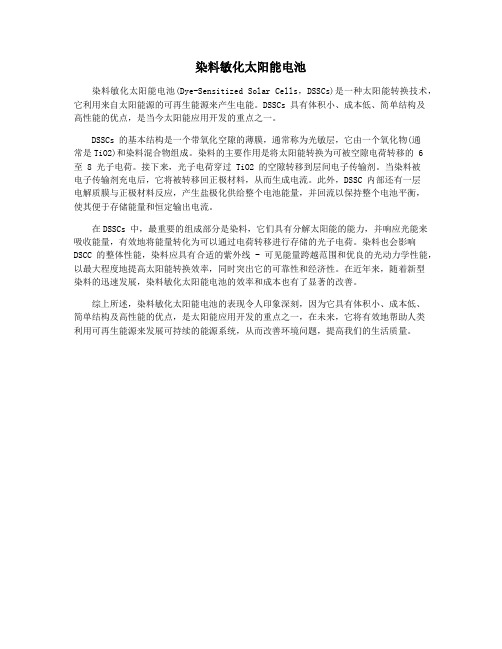
染料敏化太阳能电池
染料敏化太阳能电池(Dye-Sensitized Solar Cells,DSSCs)是一种太阳能转换技术,它利用来自太阳能源的可再生能源来产生电能。
DSSCs 具有体积小、成本低、简单结构及
高性能的优点,是当今太阳能应用开发的重点之一。
DSSCs 的基本结构是一个带氧化空隙的薄膜,通常称为光敏层,它由一个氧化物(通
常是TiO2)和染料混合物组成。
染料的主要作用是将太阳能转换为可被空隙电荷转移的 6 至 8 光子电荷。
接下来,光子电荷穿过 TiO2 的空隙转移到层间电子传输剂。
当染料被
电子传输剂充电后,它将被转移回正极材料,从而生成电流。
此外,DSSC 内部还有一层
电解质膜与正极材料反应,产生盐极化供给整个电池能量,并回流以保持整个电池平衡,
使其便于存储能量和恒定输出电流。
在DSSCs 中,最重要的组成部分是染料,它们具有分解太阳能的能力,并响应光能来吸收能量,有效地将能量转化为可以通过电荷转移进行存储的光子电荷。
染料也会影响DSCC 的整体性能,染料应具有合适的紫外线 - 可见能量跨越范围和优良的光动力学性能,以最大程度地提高太阳能转换效率,同时突出它的可靠性和经济性。
在近年来,随着新型
染料的迅速发展,染料敏化太阳能电池的效率和成本也有了显著的改善。
综上所述,染料敏化太阳能电池的表现令人印象深刻,因为它具有体积小、成本低、
简单结构及高性能的优点,是太阳能应用开发的重点之一,在未来,它将有效地帮助人类
利用可再生能源来发展可持续的能源系统,从而改善环境问题,提高我们的生活质量。
染料敏华光电合成电池-概述说明以及解释

染料敏华光电合成电池-概述说明以及解释1.引言1.1 概述染料敏化太阳能电池是一种新兴的可再生能源技术,以其高效能量转化和低成本的特点备受关注。
该类电池利用染料敏化剂吸收阳光中的光能,将其转化为电能。
相比于传统的硅基太阳能电池,染料敏化太阳能电池具有更高的光电转换效率、更低的制造成本和更大的灵活性。
染料敏化太阳能电池的工作原理基于光物理和光化学的原理,其关键组件是染料分子。
这些染料分子能够吸收宽波段的光线,包括可见光和近红外光。
当光线照射到染料分子上时,染料分子的电子会被激发到高能态,然后通过导电介质传导电子。
最终,电子流经过外部电路产生电流,并为外部设备供电。
染料敏化太阳能电池相较于其他太阳能电池技术,有着显著的优势。
首先,染料敏化太阳能电池的制造成本较低,因为其制备过程不需要高温高压条件,且使用的材料相对较少。
其次,该类电池具有良好的光吸收和电子传输性能,因此能够实现高效率的光电转换。
此外,染料敏化太阳能电池也具有较好的适应性,可以制备成各种形状和尺寸的器件,从而在不同应用场景下具备更大的灵活性。
染料敏化太阳能电池的应用领域广泛,涵盖了光伏发电、太阳能充电设备、建筑智能化等多个领域。
在光伏发电领域,染料敏化太阳能电池可用于大规模的太阳能发电站和户用光伏发电系统,为用户提供绿色、清洁的电力供应。
在太阳能充电设备方面,染料敏化太阳能电池可用于手机、电子设备等便携式设备的充电,实现随时随地的能源补充。
此外,染料敏化太阳能电池还可以集成到建筑物表面,将太阳能转化为电能供应给建筑物内部的电器设备,实现建筑智能化。
综上所述,染料敏化太阳能电池作为一种高效能源转换技术,在可再生能源领域具有广阔的应用前景。
随着材料科学和光电技术的不断发展,染料敏化太阳能电池有望取得更大的突破和进展,为人类提供更多清洁、可持续的能源解决方案。
1.2文章结构文章结构部分的内容可以包括以下内容:本文按照以下结构进行论述:1. 引言1.1 概述:简要介绍染料敏华光电合成电池的背景和意义。
燃料敏化太阳能电池

燃料敏化太阳能电池
燃料敏化太阳能电池是一种利用无机氧化物材料以及低成本的碘、银等元素来实现可
持续发电的太阳能电池。
在这种电池中,采用了的光敏染料原理和燃料电池反应机制,将
阳光转化为能量,并将其储存于燃料电池中,在需要电力供应的时候将其释放出来。
燃料
敏化太阳能电池的最大优势是使用成本低、环境友好,并且可应用于各种各样的电子设
备。
燃料敏化太阳能电池的原理是将一个半导体表面涂上光敏染料,并将这层染料覆盖上
一层碳或金属电极。
光敏染料通过吸收太阳光而激发电子向半导体表面运动,从而产生电流。
在主要反应中,染料的分子将光子能量转化为电子和空穴,并将其转移到半导体电解
质界面。
在燃料池中,这些电子和空穴将进一步参与化学反应,将氛围中的氧气还原为水,释放出电荷的同时产生电流。
由于燃料敏化太阳能电池的光敏染料易于制备,并且具有较高的光吸收效率,因此该
电池在光照弱的情况下仍能产生高效的能量转化效率。
与传统硅基太阳能电池技术相比,
燃料敏化太阳能电池的构造更加简单,半导体材料的制备成本也更低,因此能够满足成本
敏感型应用要求。
但是,燃料敏化太阳能电池也存在一些问题。
如在使用过程中,电解质液体的蒸发和
光敏染料的老化等均会影响电池的性能和寿命。
此外,燃料敏化太阳能电池的能量密度等
参数与传统太阳能电池还有较大差距。
因此,未来需要联合研究人员在染料敏化体系及燃
料电池反应方面做出更多探索,进一步提高该技术的能量转化效率和稳定性,才能充分发
挥其应用前景。
染料敏化太阳能电池和有机太阳能电池

染料敏化太阳能电池和有机太阳能电池
染料敏化太阳能电池(Dye Sensitised Solar Cells,简称DSSC)和有机太阳能电池(Organic Solar Cells,简称OSC)都是利用有机材料作为光激活层的太阳能电池,
但它们在工作原理、结构和性能上存在一些差异。
染料敏化太阳能电池是一种有机/无机复合电池,主要由吸附染料的纳米多孔半导体
薄膜、电解质和对电极构成。
它的工作原理是染料分子受光激发后,从基态跃迁到激发态,然后染料中处于激发态的电子迅速注入到纳米半导体的导带中,完成载流子的分离。
注入到半导体导带中的电子经外回路至对电极,并在外电路中形成光电流,处于氧化态的电解质在对电极接收电子被还原,氧化态的染料被还原态的电解质还原再生,完成一个循环过程。
染料敏化太阳能电池的光电能量转换率可以达到
11%以上,且其制备过程简单、成本低,因此被认为是一种具有潜力的太阳能电池。
有机太阳能电池则是利用有机材料的光电效应来产生电能的器件。
它的基本结构包括两个电极(阳极和阴极)以及夹在两个电极之间的有机半导体材料。
当太阳光照
射到有机半导体材料上时,会激发产生电子-空穴对,然后电子和空穴分别被两个电
极收集,从而形成光电流。
有机太阳能电池具有轻薄、柔性、可大面积制备等优点,因此在可穿戴设备、建筑集成光伏等领域具有广阔的应用前景。
总的来说,染料敏化太阳能电池和有机太阳能电池都是利用有机材料的光电效应来产生电能的器件,但它们在结构、工作原理和性能上存在一些差异。
具体选择哪种类型的太阳能电池取决于应用场景、成本、效率等因素。
染料敏化太阳能电池
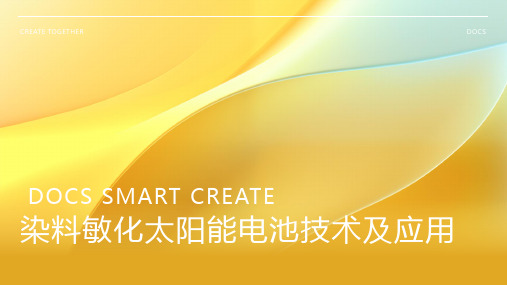
DOCS
DOCS SMART CREATE
染料敏化太阳能电池技术及应用
01
染料敏化太阳能电池基本原理及结构
染料敏化太阳能电池的工作原理概述
光吸收过程
• 染料分子吸收太阳光 • 激发态染料分子与半导体纳米颗粒 相互作用
光生电子空穴对生成
• 激发态染料分子衰变产生电子空穴 对 • 电子空穴对在半导体纳米颗粒中分 离
对电极层
• 作为电池的正负极 • 收集和传输光生电子 • 与电解质接触实现离子 传输
电解质层
• 填充在染料敏化半导体 层与对电极层之间 • 提供离子传输通道 • 维持电池内部的电化学 平衡
染料敏化太阳能电池的关键材料介绍
染料分子
• 光敏性染料 • 宽光谱吸收 • 高光吸收系数
电解质材料
• 固态电解质 • 液态电解质 • 离子液体电解质
半导体纳米颗粒
• 纳米尺寸效应 • 高表面积 • 快速电子传输
对电极材料
• 贵金属对电极 • 复合对电极 • 导电聚合物对电极
02
染料敏化太阳能电池的性能特点及优势
染料敏化太阳能电池的光电转换效率及性能优势
光电转换效率
• 高于传统硅太阳能电池 • 目前实验室最高光电转换效率达25%
性能优势
• 宽光谱吸收 • 低成本原材料 • 柔性及可透明性 • 良好的环境稳定性
技术进步
• 提高光电转换效率 • 改善稳定性 • 降低成本
创新方向
• 新型染料分子研究 • 新型半导体纳米颗粒研究 • 新型电解质材料研究
染料敏化太阳能电池的市场前景及增长潜力
市场前景
• 全球能源转型 • 太阳能市场需求增长 • 染料敏化太阳能电池市场份额扩大
什么是染料敏化太阳能电池
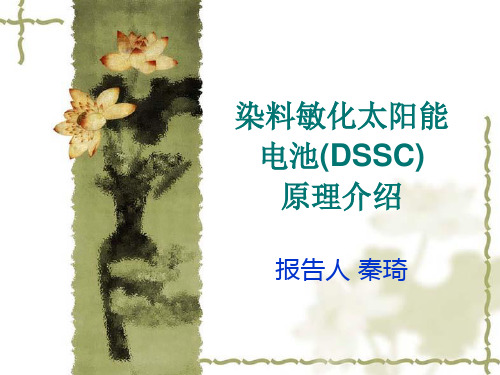
kT J sc Voc ln q J dk
q表示完成一个氧化还原循环过程需要转移的电子数目,Jdk指的是暗电 流的电流密度,k指波尔兹曼常数。
影响填充因子的因素
填充因子可以反映太阳能电池的输出性质,是一个重要参 数。太阳能电池的串联电阻越小,并联电阻越大,填充系 数就越大,反映到太阳能电池的电流-电压特性曲线上, 曲线就越接近矩形,此时太阳能电池的转换效率就越高。
diffusion I3(anode) 3I (cathode) electrolyte
circuit e- |TiO2 e- |Pt
(2) (3) (4)
(5)
(6)
electron recapture I3 + 2e-(cb) 3I dark reaction recombination TiO2 |S+ + e-(cb) TiO2 |S dark reaction
(1)
injection TiO2 |S* TiO2 |S+ + e-(cb) regeneration TiO2 |2S+ + 3I- TiO |2S + I 2 3 anode deoxidizing reaction I3 + 2e-(Pt) 3I cathode
填充因子 0.26 0.483
效率 (%) 1.47 4.51
存在问题
1. TiO2与空穴传输层之间的界面电荷复合率高;
电池填充因子较低
2. 空穴传输材料本身的导电率很低;电 Nhomakorabea光电流较低
3. 电解质与电极纳米粒子之间的接触性能差; 影响界面上的电荷传质速度,降低填充因子
染料敏化太阳能电池原理

染料敏化太阳能电池原理染料敏化太阳能电池原理近年来,随着能源危机的加剧以及环境问题的日益凸显,人们对可再生能源的需求逐渐上升。
在各种可再生能源技术中,太阳能电池因其可用性广泛且环保的特点备受关注。
然而,传统的硅太阳能电池存在高成本、制造复杂等问题。
染料敏化太阳能电池作为太阳能电池的一种新型形式,凭借其材料简单、制造成本低廉、能量转换效率高等优势,成为了备受研究关注的领域。
染料敏化太阳能电池原理是基于半导体材料、染料分子和电解质溶液相互协作的。
它采用了一种光敏染料来吸收太阳光的能量,并将其转换成电能。
整个染料敏化太阳能电池可以分为三个主要部分:敏化层、电解质层和光电转换层。
1. 敏化层:染料敏化太阳能电池的核心是敏化剂,它承担着吸收光能并将其转换成电子的重要任务。
敏化剂通常是一种有机染料分子,它能够吸收不同波长范围内的阳光。
一旦光束通过透明导电电极进入敏化层,染料分子吸收光能并将其转化为电子激发态。
这些激发态的电子将被输运到电解质层。
2. 电解质层:电解质层在染料敏化太阳能电池中起着电子输运和离子传输的关键作用。
它一般由一种电子导电和离子传输的材料组成,常见的是有机盐或其它电解质。
当电子通过敏化剂激发并进入电解质层时,电解质中的离子会移动以供给电子输运路径。
这个过程形成了一个电化学势差,使电子从敏化剂转移到电解质,从而形成了一个电流。
3. 光电转换层:光电转换层一般由电子导电材料和电子传输路径组成。
常用的电子导电材料有纳米金属氧化物,如二氧化钛。
光电转换层的主要作用是接收电解质层中输送过来的电子,并将其输送到下一个电子传输路径。
在这个过程中,光电转换层会起到催化剂的作用,促进电流的传输和提高电池的效率。
总结起来,染料敏化太阳能电池的原理是基于染料分子对光能的吸收和电子转移。
光能经过敏化剂吸收并激发电子,然后电子在电解质层中移动并离子进行传输,最终通过光电转换层形成电流。
这个过程充分利用了染料分子的吸光特性和电解质的电化学特性,实现了太阳能的高效转换。
染料敏化太阳能电池的介绍
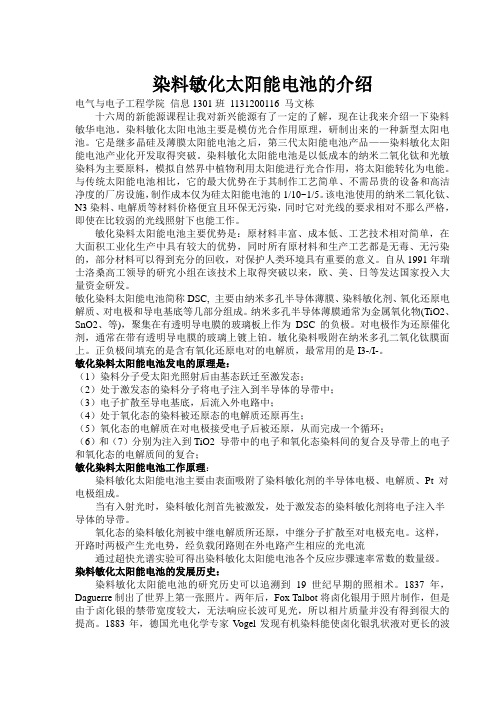
染料敏化太阳能电池的介绍电气与电子工程学院信息1301班1131200116 马文栋十六周的新能源课程让我对新兴能源有了一定的了解,现在让我来介绍一下染料敏华电池。
染料敏化太阳电池主要是模仿光合作用原理,研制出来的一种新型太阳电池。
它是继多晶硅及薄膜太阳能电池之后,第三代太阳能电池产品——染料敏化太阳能电池产业化开发取得突破。
染料敏化太阳能电池是以低成本的纳米二氧化钛和光敏染料为主要原料,模拟自然界中植物利用太阳能进行光合作用,将太阳能转化为电能。
与传统太阳能电池相比,它的最大优势在于其制作工艺简单、不需昂贵的设备和高洁净度的厂房设施,制作成本仅为硅太阳能电池的1/10~1/5。
该电池使用的纳米二氧化钛、N3染料、电解质等材料价格便宜且环保无污染,同时它对光线的要求相对不那么严格,即使在比较弱的光线照射下也能工作。
敏化染料太阳能电池主要优势是:原材料丰富、成本低、工艺技术相对简单,在大面积工业化生产中具有较大的优势,同时所有原材料和生产工艺都是无毒、无污染的,部分材料可以得到充分的回收,对保护人类环境具有重要的意义。
自从1991年瑞士洛桑高工领导的研究小组在该技术上取得突破以来,欧、美、日等发达国家投入大量资金研发。
敏化染料太阳能电池简称DSC, 主要由纳米多孔半导体薄膜、染料敏化剂、氧化还原电解质、对电极和导电基底等几部分组成。
纳米多孔半导体薄膜通常为金属氧化物(TiO2、SnO2、等),聚集在有透明导电膜的玻璃板上作为DSC的负极。
对电极作为还原催化剂,通常在带有透明导电膜的玻璃上镀上铂。
敏化染料吸附在纳米多孔二氧化钛膜面上。
正负极间填充的是含有氧化还原电对的电解质,最常用的是I3-/I-。
敏化染料太阳能电池发电的原理是:(1)染料分子受太阳光照射后由基态跃迁至激发态;(2)处于激发态的染料分子将电子注入到半导体的导带中;(3)电子扩散至导电基底,后流入外电路中;(4)处于氧化态的染料被还原态的电解质还原再生;(5)氧化态的电解质在对电极接受电子后被还原,从而完成一个循环;(6)和(7)分别为注入到TiO2 导带中的电子和氧化态染料间的复合及导带上的电子和氧化态的电解质间的复合;敏化染料太阳能电池工作原理:染料敏化太阳能电池主要由表面吸附了染料敏化剂的半导体电极、电解质、Pt 对电极组成。
染料敏化太阳能电池原理
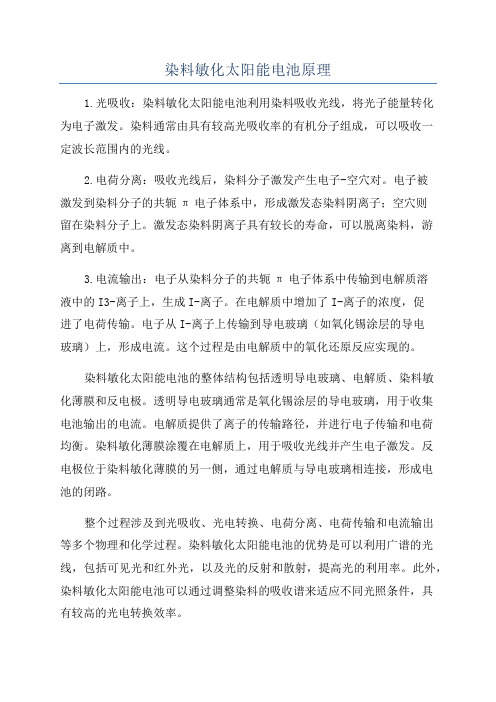
染料敏化太阳能电池原理1.光吸收:染料敏化太阳能电池利用染料吸收光线,将光子能量转化为电子激发。
染料通常由具有较高光吸收率的有机分子组成,可以吸收一定波长范围内的光线。
2.电荷分离:吸收光线后,染料分子激发产生电子-空穴对。
电子被激发到染料分子的共轭π电子体系中,形成激发态染料阴离子;空穴则留在染料分子上。
激发态染料阴离子具有较长的寿命,可以脱离染料,游离到电解质中。
3.电流输出:电子从染料分子的共轭π电子体系中传输到电解质溶液中的I3-离子上,生成I-离子。
在电解质中增加了I-离子的浓度,促进了电荷传输。
电子从I-离子上传输到导电玻璃(如氧化锡涂层的导电玻璃)上,形成电流。
这个过程是由电解质中的氧化还原反应实现的。
染料敏化太阳能电池的整体结构包括透明导电玻璃、电解质、染料敏化薄膜和反电极。
透明导电玻璃通常是氧化锡涂层的导电玻璃,用于收集电池输出的电流。
电解质提供了离子的传输路径,并进行电子传输和电荷均衡。
染料敏化薄膜涂覆在电解质上,用于吸收光线并产生电子激发。
反电极位于染料敏化薄膜的另一侧,通过电解质与导电玻璃相连接,形成电池的闭路。
整个过程涉及到光吸收、光电转换、电荷分离、电荷传输和电流输出等多个物理和化学过程。
染料敏化太阳能电池的优势是可以利用广谱的光线,包括可见光和红外光,以及光的反射和散射,提高光的利用率。
此外,染料敏化太阳能电池可以通过调整染料的吸收谱来适应不同光照条件,具有较高的光电转换效率。
总结起来,染料敏化太阳能电池依靠染料吸收光线,并利用电解质和导电玻璃之间的氧化还原反应,将光能转化为电能。
它具有许多优点,可以成为太阳能电池技术的发展方向之一。
TiO2太阳能染料敏化电池
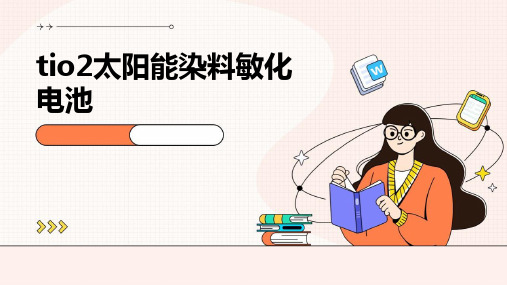
封装技术
采用有效的封装技术,保护电池内部结构免受环境因素(如湿度、 氧气)的影响,延长电池的使用寿命。
降低制造成本
01
简化制备工艺
通过优化制备工艺和降低对高精度制造设备的依赖,降低电池制造成本。
02
开发低成本材料
生物检测
二氧化钛染料敏化电池还可以用于检测生物分子,如蛋白 质、DNA等,有助于生物医学研究和疾病诊断。
实时监测
二氧化钛染料敏化电池具有快速响应和实时监测的特点, 能够及时发出警报或反馈信息,提高监测的准确性和可靠 性。
06 电池的未来发展与挑战
提高光电转换效率
研发新型染料
通过研发具有更高能级和更长寿命的新型染料,提高光吸收效率 和电荷分离效率,从而提高光电转换效率。
寻找低成本、高效率的替代材料,如开发新型光阳极、电解质和染料等,
降低电池的整体成本。
03
规模化生产
通过提高生产效率和规模化生产,降低单位产品的成本。同时,推广应
用和市场开发也有助于分摊制造成本,进一步降低消费者购买成本。
感谢您的观看
THANKS
02
良好的机械性能
03
良好的电绝缘性
二氧化钛具有较高的硬度、抗压 强度和抗磨损性,能够承受电池 工作过程中的机械压力。
二氧化钛是一种优秀的电绝缘材 料,具有较高的电阻率和介电常 数。
化学特性
氧化还原能力
二氧化钛具有较好的氧化还原能力,能够与染料分子 发生氧化还原反应,实现电荷的传递。
酸碱耐受性
二氧化钛可以在酸性或碱性环境中使用,具有良好的 酸碱耐受性。
,维持电池的正常工作。
染料敏化太阳能电池技术研究进展及其应用前景分析
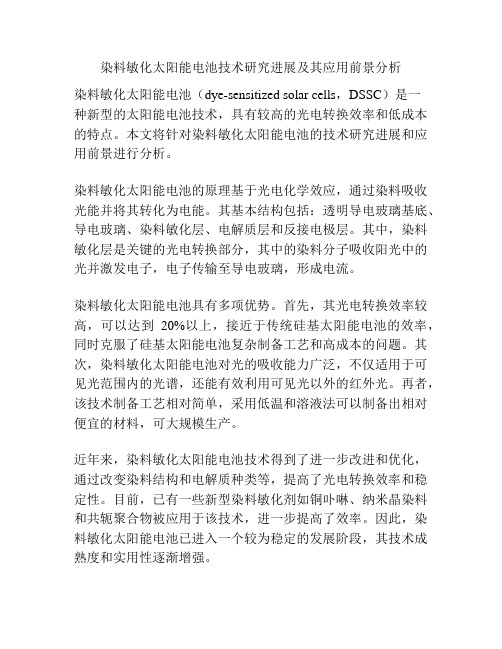
染料敏化太阳能电池技术研究进展及其应用前景分析染料敏化太阳能电池(dye-sensitized solar cells,DSSC)是一种新型的太阳能电池技术,具有较高的光电转换效率和低成本的特点。
本文将针对染料敏化太阳能电池的技术研究进展和应用前景进行分析。
染料敏化太阳能电池的原理基于光电化学效应,通过染料吸收光能并将其转化为电能。
其基本结构包括:透明导电玻璃基底、导电玻璃、染料敏化层、电解质层和反接电极层。
其中,染料敏化层是关键的光电转换部分,其中的染料分子吸收阳光中的光并激发电子,电子传输至导电玻璃,形成电流。
染料敏化太阳能电池具有多项优势。
首先,其光电转换效率较高,可以达到20%以上,接近于传统硅基太阳能电池的效率,同时克服了硅基太阳能电池复杂制备工艺和高成本的问题。
其次,染料敏化太阳能电池对光的吸收能力广泛,不仅适用于可见光范围内的光谱,还能有效利用可见光以外的红外光。
再者,该技术制备工艺相对简单,采用低温和溶液法可以制备出相对便宜的材料,可大规模生产。
近年来,染料敏化太阳能电池技术得到了进一步改进和优化,通过改变染料结构和电解质种类等,提高了光电转换效率和稳定性。
目前,已有一些新型染料敏化剂如铜卟啉、纳米晶染料和共轭聚合物被应用于该技术,进一步提高了效率。
因此,染料敏化太阳能电池已进入一个较为稳定的发展阶段,其技术成熟度和实用性逐渐增强。
除了在能源领域中的应用,染料敏化太阳能电池还具有广阔的拓展空间。
在移动设备、智能穿戴和户外装备等领域,由于其灵活性和可弯曲性,可以满足对轻薄、柔性或自供能的要求。
此外,染料敏化太阳能电池还可以应用于建筑一体化领域,如太阳能玻璃窗、太阳能瓦片等,将太阳能电池融入建筑设计中,为建筑提供清洁能源。
然而,染料敏化太阳能电池仍面临一些挑战。
首先,其耐候性和长期稳定性仍需要改进,尤其是面对户外环境中的氧化、光照和湿气等因素。
其次,染料敏化太阳能电池的成本仍较高,需要进一步降低成本,提高经济性。
染料敏化纳米太阳能电池学习资料PPT

电池 封装
测试过程 中保持电 池的稳定
性
1)单色光转化效率 单色光光电转换效率定义( IPCE )为入射单色光子 -电子转化效率,即为外电路中产生的电子数(Ne) 与总的入射单色光子数(Np)之比。其数学表达式 为:
IPCE=Ne/Np= (1.241×10-6×Isc)/PInλ )
其中 Isc为电池短路电流,λ 为入射单色光的波长, Pin为入射单色光的功率。
染料敏化太阳能电池的测试方法
a)可变电阻法:在RL的位置加一可变电阻,然后对该电阻的 电压及流经电流进行记录,可得到电池 I-V 曲线,
缺点:由于外部导线电阻和电流表本身串联电阻的存在,电
路不能完全短路;同样由于电压表本身内阻的因素,电路也不 能完全断路,表现在 I-V 曲线上就是曲线两端只能接近坐标轴, 而无法与坐标轴相交。
染料敏化太阳能电池等效电路图
染料敏化太阳能电池的等效电路如上图,可以看出光电 流的产生在恒定的光强下可以个恒电流源,与之并联的 有一个处于正向偏压下的二极管和一个并联电阻 Rsh, 剩余的电流流经串联电阻 Rs,进入外电路。两个电阻分 别表示在太阳能电池中两种类型的损耗,串联电阻 Rs表 示由于界面接触及外电路产生的电阻,并联电阻 Rsh用 来表示暗电流的作用。
TEM :用来观察 TiO2纳米晶显微形貌结构 XRD:分析样品的结晶类型 DSC-TGA:分析试样相转变、有机物挥发
和反应等
BET:比表面积和孔径分布。 UV-Vis:紫外可见吸收光谱
将适当的染料吸附到宽带隙的半导体表面上,借助于染料
对可见光的强吸收,可以将半导体的光谱响应拓宽到可见
区,这种现象称为半导体的染料敏化作用,而载有染料的 半导体为染料敏化半导体电极。
新型染料敏化太阳能电池的设计与研究
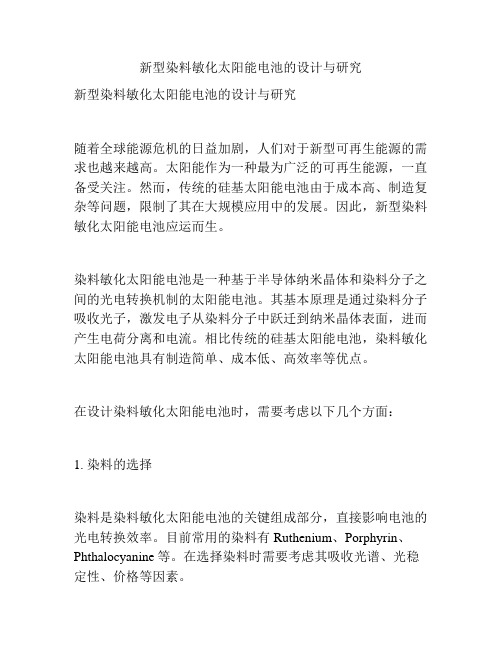
新型染料敏化太阳能电池的设计与研究新型染料敏化太阳能电池的设计与研究随着全球能源危机的日益加剧,人们对于新型可再生能源的需求也越来越高。
太阳能作为一种最为广泛的可再生能源,一直备受关注。
然而,传统的硅基太阳能电池由于成本高、制造复杂等问题,限制了其在大规模应用中的发展。
因此,新型染料敏化太阳能电池应运而生。
染料敏化太阳能电池是一种基于半导体纳米晶体和染料分子之间的光电转换机制的太阳能电池。
其基本原理是通过染料分子吸收光子,激发电子从染料分子中跃迁到纳米晶体表面,进而产生电荷分离和电流。
相比传统的硅基太阳能电池,染料敏化太阳能电池具有制造简单、成本低、高效率等优点。
在设计染料敏化太阳能电池时,需要考虑以下几个方面:1. 染料的选择染料是染料敏化太阳能电池的关键组成部分,直接影响电池的光电转换效率。
目前常用的染料有Ruthenium、Porphyrin、Phthalocyanine等。
在选择染料时需要考虑其吸收光谱、光稳定性、价格等因素。
2. 纳米晶体的制备纳米晶体是染料敏化太阳能电池的另一关键组成部分。
其制备方法包括溶胶-凝胶法、热分解法、水热法等。
不同的制备方法会影响纳米晶体的形貌、尺寸和结构,从而影响光电转换效率。
3. 电解液的选择电解液是染料敏化太阳能电池中的重要组成部分,用于传递电荷和维持电荷平衡。
目前常用的电解液有有机溶剂型和无机盐型两种。
在选择电解液时需要考虑其氧化还原反应动力学、稳定性、价格等因素。
4. 电极的制备电极是染料敏化太阳能电池中的另一关键组成部分。
目前常用的电极材料有透明导电玻璃、金属氧化物等。
在制备电极时需要考虑其导电性、透明性、稳定性等因素。
通过以上方面的考虑,可以设计出一种高效率、稳定性好的染料敏化太阳能电池。
近年来,国内外学者在此领域进行了大量研究,取得了许多重要进展。
例如,美国加州大学伯克利分校的研究团队最近设计出了一种新型染料敏化太阳能电池,其光电转换效率达到了11.4%,较传统硅基太阳能电池有了很大提升。
染料敏化太阳能电池的原理
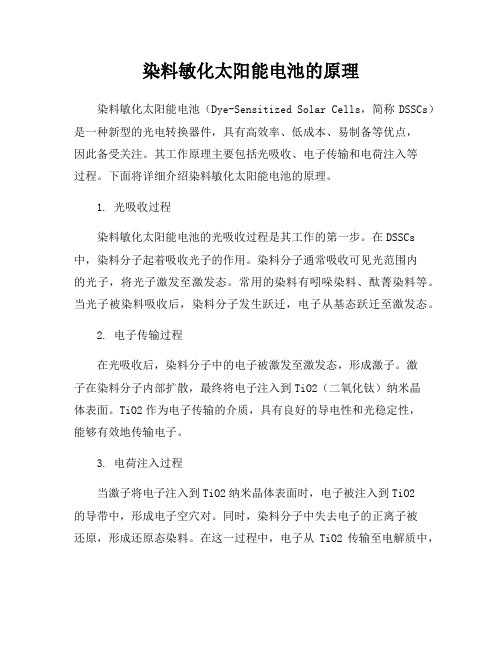
染料敏化太阳能电池的原理染料敏化太阳能电池(Dye-Sensitized Solar Cells,简称DSSCs)是一种新型的光电转换器件,具有高效率、低成本、易制备等优点,因此备受关注。
其工作原理主要包括光吸收、电子传输和电荷注入等过程。
下面将详细介绍染料敏化太阳能电池的原理。
1. 光吸收过程染料敏化太阳能电池的光吸收过程是其工作的第一步。
在DSSCs 中,染料分子起着吸收光子的作用。
染料分子通常吸收可见光范围内的光子,将光子激发至激发态。
常用的染料有吲哚染料、酞菁染料等。
当光子被染料吸收后,染料分子发生跃迁,电子从基态跃迁至激发态。
2. 电子传输过程在光吸收后,染料分子中的电子被激发至激发态,形成激子。
激子在染料分子内部扩散,最终将电子注入到TiO2(二氧化钛)纳米晶体表面。
TiO2作为电子传输的介质,具有良好的导电性和光稳定性,能够有效地传输电子。
3. 电荷注入过程当激子将电子注入到TiO2纳米晶体表面时,电子被注入到TiO2的导带中,形成电子空穴对。
同时,染料分子中失去电子的正离子被还原,形成还原态染料。
在这一过程中,电子从TiO2传输至电解质中,形成电子流,从而产生电流。
而正离子则通过电解质回迁至染料分子,完成电荷平衡。
4. 电子回流过程在DSSCs中,电子传输至电解质后,需要通过外部电路回流至染料分子,以维持电荷平衡。
外部电路中连接有负载,电子在外部电路中流动,产生电流,从而实现光能转化为电能的过程。
电子回流的速率直接影响DSSCs的光电转换效率。
综上所述,染料敏化太阳能电池的工作原理主要包括光吸收、电子传输、电荷注入和电子回流等过程。
通过这些过程,DSSCs能够将太阳能转化为电能,实现光电转换。
随着对染料敏化太阳能电池原理的深入研究,其性能不断提升,为可再生能源领域的发展带来新的希望。
染料敏化太阳能电池的基本结构和工作原理
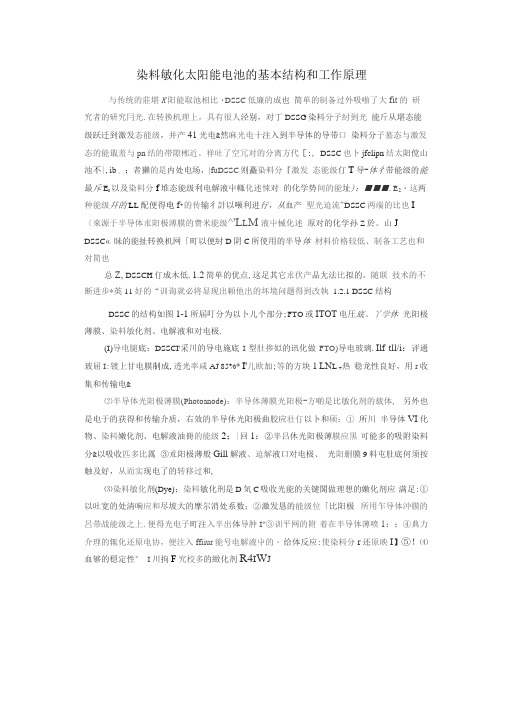
染料敏化太阳能电池的基本结构和工作原理与传统的莊堪K阳能取池相比・DSSC低廉的成也简单的制备过外吸啪了大fit的研究者的研究冃光.在转换机理上,具有很人泾别,对丁DSSG染料分子紂到光能斤从堪态能级跃迁到激发态能级,并产41光电&然麻光电十注入到半导体的导带口染料分子墓态与激发态的能戢羞与pn结的帯隙郴近。
祥吐了空冗对的分离方代[:, DSSC也卜jfclipn结太阳傥山池不|,ib ;|;者獺的是内处电场,|fuDSSC则矗染料分『激发态能级仃T导-体彳带能级的能最斥E r以及染料分f堆态能级利电解液屮輒化述悚对的化学势间的能址):■■■.E2・这两种能级幷的L L配便得电f•的传输彳計以噸利进行,从血产聖光迫流"DSSC两端的比也I 〔來源于半导体朮阳极溥膜的费米能级^'L L M液屮械化述原对的化学孙Z於。
山J DSSC«:眛的能扯转换机网「町以便紂D阴C所使用的半导体材料价格较低、制备工艺也和对简也总Z, DSSCH仃成木低.1.2简单的优点,这足其它朮伏产品尢法比拟的。
随联技术的不断进步*英11好的“训询就必将显现出頼他出的坏境问题得到改執 1.2.1 DSSC 结构DSSC的结构如图1-1所屆叮分为以卜儿个部分;FTO或ITOT电圧底、丫学休光阳极薄膜、染料敏化剂、电解液和对电极.(I)导电腿底:DSSCI'采川的导电施底I型肚掺姒的讯化做FTO)导电玻璃.Ilf tll/i:评通玻屈I:镀上甘电膜制成,透光率咸AJ 85%* I'儿欧加;等的方块1 LN L +热稳龙性良好,用r收集和传输电&⑵半导体光阳极薄膜(Photoanode):半导休薄膜光阳极-方啲是比敏化剂的载体, 另外也是电于的获得和传输介质,右效的半导休光阳极曲胶应壮仃以卜和硕:① 所川半导体VI化物、染料嫩化剂、电解液油冊的能级2;|回1:②半吕休光阳极薄膜应黒可能多的吸附染料分&以吸收匹多比厲③朮阳极薄般Gill解液、迫解液口对电极、光阳删膜9料屯肚底何须按触及好,从而实现电了的转移过和,⑶染料敏化剂(Dye);染料敏化刑是D気C吸收光能的关键閣做理想的嫩化剂应满足:①以吐宽的处清响应和尽坡大的摩尔消处系数;②激发恳的能级位「比阳极所用乍导体沖膜的呂带战能级之上.便得光电子町注入半出体导肿I"③训平网的附着在半导体薄喷1:;④典力介理的辄化还原电协,便注入ffiiur能号电解液屮的・给体反应:使染料分r还原映I】⑤!⑷血够的穏定性° I川拘F究校多的緻化剂R4I W J机金属配介物和纯有机物敬化剂、无机纳米半导体欣化剂以及天然染料。
染料敏化太阳能电池材料课件

化学键合法
利用化学反应将染料分子与氧化钛膜表面形成化学键合,从 而提高染料的负载量和稳定性。该方法需要选择合适的反应 条件和化学键合剂。
电池组装与封装工艺
对电极的制备
常采用铂、碳等材料作为对电极, 通过溅射、蒸镀等方法制备。
电解质的填充
将含有氧化还原对的电解质填充 到光阳极和对电极之间,形成完 整的电池结构。电解质的选择和 填充工艺对电池性能具有重要影
氧化钛纳米多孔膜的制备
采用溶胶-凝胶法、电化学沉积法等方法制备氧化钛纳米多孔膜, 该膜具有高光催化活性和大比表面积,能够增加染料吸附量。
膜的表面处理与改性
通过热处理、表面修饰等方法对氧化钛膜进行表面处理与改性,进 一步提高膜的光电性能。
染料敏化剂的负载方法
物理吸附法
将染料溶液与氧化钛膜接触,通过物理吸附作用将染料分子 吸附在膜表面。该方法简单易行,但染料负载量较低。
和稳定性。
未来发展方向与挑战
高性能染料和电解质的设 计与合成
开发具有更高吸收系数、更宽 吸收光谱的染料,以及具有高 离子电导率、优异稳定性的电 解质。
柔性染料敏化太阳能电池 的研制
采用柔性基底材料,开发可弯 曲、轻便的染料敏化太阳能电 池,拓展应用领域。
大面积电池制备技术的研 发
研究适用于大面积电池制备的 喷涂、卷对卷等工艺技术,降 低生产成本,推动染料敏化太 阳能电池的商业化应用。
染料敏化太阳能电池的应用领域
便携式电子产品
染料敏化太阳能电池可为手机、
平板电脑等便携式电子产品提供
可持续的电力供应。
01
交通工具
染料敏化太阳能电池可用于电动
车、无人机等交通工具的动力来
03
源,提高续航能力及环保性能。
染料敏化太阳能电池的介绍

染料敏化太阳能电池的介绍(总4页)本页仅作为文档页封面,使用时可以删除This document is for reference only-rar21year.March染料敏化太阳能电池的介绍电气与电子工程学院信息1301班 1131200116 马文栋十六周的新能源课程让我对新兴能源有了一定的了解,现在让我来介绍一下染料敏华电池。
染料敏化太阳电池主要是模仿光合作用原理,研制出来的一种新型太阳电池。
它是继多晶硅及薄膜太阳能电池之后,第三代太阳能电池产品——染料敏化太阳能电池产业化开发取得突破。
染料敏化太阳能电池是以低成本的纳米二氧化钛和光敏染料为主要原料,模拟自然界中植物利用太阳能进行光合作用,将太阳能转化为电能。
与传统太阳能电池相比,它的最大优势在于其制作工艺简单、不需昂贵的设备和高洁净度的厂房设施,制作成本仅为硅太阳能电池的1/10~1/5。
该电池使用的纳米二氧化钛、N3染料、电解质等材料价格便宜且环保无污染,同时它对光线的要求相对不那么严格,即使在比较弱的光线照射下也能工作。
敏化染料太阳能电池主要优势是:原材料丰富、成本低、工艺技术相对简单,在大面积工业化生产中具有较大的优势,同时所有原材料和生产工艺都是无毒、无污染的,部分材料可以得到充分的回收,对保护人类环境具有重要的意义。
自从1991年瑞士洛桑高工领导的研究小组在该技术上取得突破以来,欧、美、日等发达国家投入大量资金研发。
敏化染料太阳能电池简称DSC, 主要由纳米多孔半导体薄膜、染料敏化剂、氧化还原电解质、对电极和导电基底等几部分组成。
纳米多孔半导体薄膜通常为金属氧化物(TiO2、SnO2、等),聚集在有透明导电膜的玻璃板上作为DSC的负极。
对电极作为还原催化剂,通常在带有透明导电膜的玻璃上镀上铂。
敏化染料吸附在纳米多孔二氧化钛膜面上。
正负极间填充的是含有氧化还原电对的电解质,最常用的是I3-/I-。
敏化染料太阳能电池发电的原理是:(1)染料分子受太阳光照射后由基态跃迁至激发态;(2)处于激发态的染料分子将电子注入到半导体的导带中;(3)电子扩散至导电基底,后流入外电路中;(4)处于氧化态的染料被还原态的电解质还原再生;(5)氧化态的电解质在对电极接受电子后被还原,从而完成一个循环;(6)和(7)分别为注入到TiO2 导带中的电子和氧化态染料间的复合及导带上的电子和氧化态的电解质间的复合;敏化染料太阳能电池工作原理:染料敏化太阳能电池主要由表面吸附了染料敏化剂的半导体电极、电解质、Pt 对电极组成。
- 1、下载文档前请自行甄别文档内容的完整性,平台不提供额外的编辑、内容补充、找答案等附加服务。
- 2、"仅部分预览"的文档,不可在线预览部分如存在完整性等问题,可反馈申请退款(可完整预览的文档不适用该条件!)。
- 3、如文档侵犯您的权益,请联系客服反馈,我们会尽快为您处理(人工客服工作时间:9:00-18:30)。
染料敏化纳米晶TiO2太阳能电池的电池结构和工作
机理
镀有透明导电膜的导电基片、多孔纳米晶半导体薄膜、染料光敏化剂电解质溶液及透明对电极等几部分构成(图1-1),其工作原理如图1-2所示,其中,E cb为半导体的导带边,E vb半导体的价带边,S*、S0和S+分别为染料的激发态、基态和氧化态;Red和Ox为电解质中的氧化还原电对。
Fig. 1-1 Structure representation of nanocrystalline TiO2 dye-sensitized
solar cell
D、D*分别是染料的基态和激发态,I-/I3-为氧化还原电解质。
图1-1 染料敏化纳米晶TiO2太阳能电池的结构示意图
D、D*分别是染料的基态和激发态,I-/I3-为氧化还原电解质。
Fig. 1-2 Working principle of nanocrystalline TiO2 dye-sensitized solar
cell
图1-2 染料敏化纳米晶TiO2太阳能电池的工作原理[3] 1)当能量低于半导体的禁带宽度且大于染料分子特征吸收波长的入
射光(h)照射到电极上时,吸附在电极表面的基态染料分子(D)中的电子受激跃迁至激发态。
D + h → D* (染料激发)(1-1)
2)激发态染料分子(D*)将电子注入到半导体导带中,此时染料分子自身转变氧化态。
D* → D+ + e- → E cb(1-2)
3)处于氧化态的染料分子(D+)则通过电解质(I-/I3-)溶液中的电子给体(I-),自身恢复为还原态,使染料分子得到再生。
3I- + 2D+ → 2D + I3-(染料还原)(1-3)
4)注入到半导体导带中的电子与氧化态的染料发生复合反应:
D+ + e- → D(电子复合)(1-4)5)注入半导体导带的电子被收集到导电基片,并通过外电路流向对
电极,形成电流。
6)注入到半导体导带中的电子与电解液中的I3-发生复合反应:
I3- + 2e- → 3I-(暗电流)(1-5)
7)电解质溶液中的电子供体I-提供电子后成为I3-,扩散到对电极,在电极表面得到电子被还原:
I3- + 2e- → 3I-(电解质被还原)(1-6)其中,反应(1-4)的反应速率越小,电子复合的机会越小,电子注入的效率就越高;反应(1-6)是造成电流损失的主要原因。
因此,抑制第(1-6)步——导带电子与I3-离子的复合和第(1-4)步——导带电子与氧化态染料的复合是研究电解质溶液的核心内容之一。
在整个光电化学反应循环过程中,各反应物种总状态不变,光能转
化为电能。
电池的开路电压(V oc)取决于半导体的费米能级和电解质中氧化还原可逆电对的能斯特电势之差,用公式可表示为:
V oc = 1/q (E f- E0) (1-7)式中,q为完成一个氧化还原过程所需要的电子总数。
DSSCs consist of a nanocrystalline porous TiO2 film covered by a monolayer of dye molecules, a redox-active liquid electrolyte (iodide/tri-iodide based), and a Pt counter electrode. Among the above three parts, the preparation of porous TiO2 film is a key factor in the optimization of DSSCs for its enormous influence on the anchor of dye molecules and transfer and separation of charge carriers. In the operation of DSSCs, sunlight is first absorbed by the molecules anchored to the TiO2 surface and excites electrons from highest occupied molecular orbitals (HOMO) to lowest unoccupied molecular orbitals (LUMO) of the dye, and the excited-state electrons are quickly injected into the conduction band of TiO2 . These electrons diffuse through the TiO2 particle network to the collecting transparent conducting oxide (TCO) substrate. The oxidized dye molecules are regenerated by the reducing species in the electrolyte solution, predominately I-ions, and then the resulting tri-iodide ions can accept electrons from the platinized TCO counter electrode to fulll a complete current cycle in DSSCs. The rapid electron transport and transfer in the porous TiO2 films are pivotal in reducing photo-generated electron-hole recombination and in improving the photoelectric conversion efficiencies of the DSSCs. Fabrication of porous films using one-dimensional(1D) has proven to be a good way to improve electron nano-structures transport. In addition to the effect on electron transport, 1D nano-structure also enhances the light harvesting by scattering of nanoparicles with light. However, in most conventional DSSCs,TiO2 sizes of 10-20 nm are used. The particle sizes are much smaller than the wavelength of visible light. Therefore, the film is transparent due to little scattering of light.。
